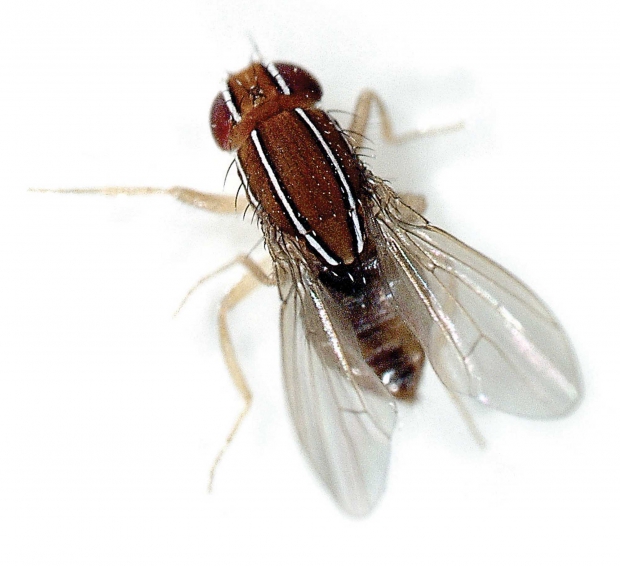
The African fig fly is easily recognized by its racing stripes. It is larger than other drosophila flies.(Courtesy Doug Pfeiffer, Virginia Tech
Another invasive species of drosophila fly, which can be identified by its “racing stripes,” has arrived in the United States with the potential to infest a wide range of crops.
The African fig fly (Zaprionus indianus) is native to Africa, the Middle East, and Eurasia, and is now found in much of South and Central America, where it is mainly a pest of figs. It was first found in the United States in 2005 in Florida, where it quickly spread and outcompeted other flies, according to information from Pennsylvania State University.
It was noticed in Pennsylvania two years ago when adult flies were caught in apple cider vinegar traps being used to monitor the spotted wing drosophila and in Virginia where it was collected from fruit.
Dr. Doug Pfeiffer, entomologist at Virginia Tech, said the African fig fly has been found in Virginia, New England, Michigan, and Minnesota. On the West Coast, it’s been seen in San Diego, California, but not yet in the state’s fruit-growing districts.
Stripes
Although the fig fly is from the drosophilid family, it can easily be distinguished from spotted wing drosophila (Drosophila suzukii) and the vinegar fly (Drosophila melangaster) by a pair of silvery white stripes that run the length of its body. It is also slightly larger. Because of the stripes, Pennsylvania Department of Agriculture has nicknamed it the speed racer fly.
Pfeiffer said the fly originated in a tropical climate and appears unable to overwinter in the northern areas of the United States.
“It doesn’t even overwinter in northern Florida,” he said. “It has to move up from southern Florida each year.”
But the fly is able to move long distances, probably carried by the wind, he said. “I think what happens is it becomes aerial plankton and as air currents move, it’s carried along by the wind.”
Because it needs to reestablish in northern fruit-growing regions each year, Pfeiffer expects it will be a late-season pest. Unlike spotted wing drosophila, the female fig fly has a weak ovipositor—the organ she uses to pierce fruit and deposit eggs—and so primarily infests overripe fruit or fruit that’s already damaged.
The insect came to Pfeiffer’s attention when he and his colleagues were studying infested grape clusters in a Virginia vineyard.
When they reared out the insects, expecting them to be spotted wing drosophila, 90 percent turned out to be the African fig fly. His hypothesis is that the fig fly is invading fruit injured by the spotted wing drosophila, which attacks less mature fruit on the tree, and this could happen with soft fruits as well as grapes.
However, he doesn’t see the two species working together to compound fruit damage because previous research with 27 drosophila species showed that the fig fly is one of the most competitive of all and would likely outcompete spotted wing drosophila.
Pfeiffer and his colleagues are tracking movement of the African fig fly and studying the interactions between the species. They are also testing lures and baits to find out how attractive they are to each of them. The African fig fly has shown up in apple cider vinegar traps intended for spotted wing drosophila but not in high numbers. Scientists have been using mashed banana sprinkled with yeast as a bait.
Dr. Peter Landolt, research leader and entomologist with the U.S. Department of Agriculture in Yakima, Washington, who has developed a new lure for the spotted wing drosophila (see “A better fly trap”), has also worked on the African fig fly.
Landolt said flies use volatiles as a way of seeking out their preferred foods, which differ from species to species.
In lab tests, he exposed fly antennae of spotted wing drosophila, the African fig fly, and the common vinegar fly to volatiles of wine and vinegar to find out which specific chemicals they were drawn to. Although there was some overlap, the most attractive blend of chemicals differed for each one. •
A map showing the distribution of the insect in the U.S. can be found at http://bit.ly/1iyIuNX.






Leave A Comment